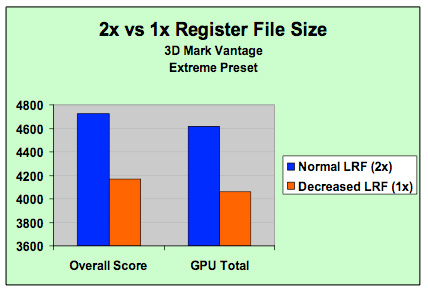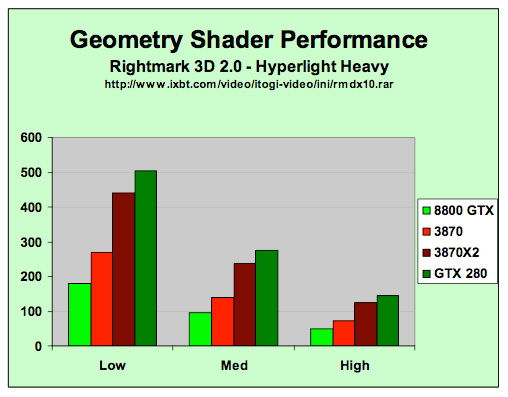NVIDIA's 1.4 Billion Transistor GPU: GT200 Arrives as the GeForce GTX 280 & 260
by Anand Lal Shimpi & Derek Wilson on June 16, 2008 9:00 AM EST- Posted in
- GPUs
Tweaks and Enahancements in GT200
NVIDIA provided us with a list, other than the obvious addition of units and major enhancements in features and technology, of adjustments made from G80 to GT200. These less obvious changes are part of what makes this second generation Tesla architecture a well evolved G80. First up, here's a quick look at percent increases from G80 to GT200.
| NVIDIA Architecture Comparison | 8800 GTX | GTX 280 | % Increase |
| Cores | 128 | 240 | 87.5% |
| Texture | 64t/clk | 80t/clk | 25% |
| ROP Blend | 12p / clk | 32p / clk | 167% |
| Max Precision | fp32 | fp64 | |
| GFLOPs | 518 | 933 | 80% |
| FB Bandwidth | 86 GB/s | 142 GB/s | 65% |
| Texture Fill Rate | 37 GT/s | 48 GT/s | 29.7% |
| ROP Blend Rate | 7 GBL/s | 19 GBLs | 171% |
| PCI Express Bandwidth | 6.4 GB/s | 12.8GB/s | 100% |
| Video Decode | VP1 | VP2 |
Communication between the driver and the front-end hardware has been enhanced through changes to the communications protocol. These changes were designed to help facilitate more efficient data movement between the driver and the hardware. On G80/G92, the front-end could end up in contention with the "data assembler" (input assembler) when performing indexed primitive fetches and forced the hardware to run at less than full speed. This has been fixed with GT200 through some optimizations to the memory crossbar between the assembler and the frame buffer.
The post-transform cache size has been increased. This cache is used to hold transformed vertex and geometry data that is ready for the viewport clip/cull stage, and increasing the size of it has resulted in faster communication and fewer pipeline stalls. Apparently setup rates are similar to G80 at up to one primative per clock, but feeding the setup engine is more efficient with a larger cache.
Z-Cull performance has been improved, while Early-Z rejection rates have increased due to the addition of more ROPs. Per ROP, GT200 can eliminate 32 pixles (or up to 256 samples with 8xAA) per clock.
The most vague improvement we have on the list is this one: "significant micro-architectural improvements in register allocation, instruction scheduling, and instruction issue." These are apparently the improvements that have enabled better "dual-issue" on GT200, but that's still rather vague as to what is actually different. It is mentioned that scheduling between the texture units and SMs within a TPC has also been improved. Again, more detail would be appreciated, but it is at least worth noting that some work went into that area.
Register Files? Double Em!
Each of those itty-bitty SPs is a single-core microprocessor, and as such it has its own register file. As you may remember from our CPU architecture articles, registers are storage areas used to directly feed execution units in a CPU core. A processor's register file is its collection of registers and although we don't know the exact number that were in G80's SPs, we do know that the number has been doubled for GT200.

NVIDIA's own data shows a greater than 10% increase in performance due to the larger register file size (source: NVIDIA)
If NVIDIA is betting that games are going to continue to get more compute intensive, then register file usage should increase as well. More computations means more registers in use, which in turn means that there's a greater likelihood of running out of registers. If a processor runs out of registers, it needs to start swapping data out to much slower memory and performance suffers tremendously.
If you haven't gotten the impression that NVIDIA's GT200 is a compute workhorse, doubling the size of the register file per SP (multiply that by 240 SPs in the chip) should help drive the idea home.
Double the Precision, 1/8th the Performance
Another major feature of the GT200 GPU and cards based on it is support for hardware double precision floating point operations. Double precision FP operations are 64-bits wide vs. 32-bit for single precision FP operations.
Now the 240 SPs in GT200 are single-precision only, they simply can't accept 64-bit operations at all. In order to add hardware level double precision NVIDIA actually includes one double precision unit per shading multiprocessor, for a total of 30 double precision units across the entire chip.
The ratio of double precision to single precision hardware in GT200 is ridiculously low, to the point that it's mostly useless for graphics rasterization. It is however, useful for scientific computing and other GPGPU applications.
It's unlikely that 3D games will make use of double precision FP extensively, especially given that 8-bit integer and 16-bit floating point are still used in many shader programs today. If anything, we'll see the use of DP FP operations in geometry and vertex operations first, before we ever need that sort of precision for color - much like how the transition to single precision FP started first in vertex shaders before eventually gaining support throughout the 3D pipeline.
Geometry Wars
ATI's R600 is alright at geometry shading. So is RV670. G80 didn't really keep up in this area. Of course, games haven't really made extensive use of geometry shaders because neither AMD nor NVIDIA offered compelling performance and other techniques made more efficient use of the hardware. This has worked out well for NVIDIA so far, but they couldn't ignore the issue forever.
GT200 has enhanced geometry shading support over G80 and is now on par with what we wish we had seen last year. We can't fault NVIDIA too much as with such divergent new features they had to try and predict the usage models that developers might be interested in years in advance. Now that we are here and can see what developers want to do with geometry shading, it makes sense to enhance the hardware in ways that support these efforts.

GT200 has significantly improved geometry shader performance compared to G80 (source: NVIDIA)
Generation of vertex data is a particularly weak part of NVIDIA's G80, so GT200 is capable of streaming out 6x the data of G80. Of course there are the scheduling enhancements that affect everything, but it is unclear as to whether NVIDIA did anything beyond increasing the size of their internal output buffers by 6x in order to enhance their geometry shading capability. Certainly this was lacking previously, but hopefully this will make heavy use of the geometry shader something developers are both interested in and can take advantage of.










108 Comments
View All Comments
tkrushing - Wednesday, June 18, 2008 - link
Say what you want about this guy but this is partially true which is why AMD/ATI is in the position they have been. They are slowly climbing out of that hole they've been in though. Would have been nice to see 4870x2 hit the market first. As we know competition = less prices for everyone!hk690 - Tuesday, June 17, 2008 - link
I would love to kick you hard in the face, breaking it. Then I'd cut your stomach open with a chainsaw, exposing your intestines. Then I'd cut your windpipe in two with a boxcutter. Then I'd tie you to the back of a pickup truck, and drag you, until your useless fucking corpse was torn to a million fucking useless, bloody, and gory pieces.
Hopefully you'll get what's coming to you. Fucking bitch
http://www.youtube.com/watch?v=XNAFUpDTy3M">http://www.youtube.com/watch?v=XNAFUpDTy3M
I wish you a truly painful, bloody, gory and agonizing death, cunt
7Enigma - Wednesday, June 18, 2008 - link
Anand, I'm all for free speech and such, but this guy is going a bit far. I read these articles at work frequently and once the dreaded C-word is used I'm paranoid I'm being watched.Mr Roboto - Thursday, June 19, 2008 - link
I thought those comments would be deleted already. I'm sure no one cares if they are. I don't know what that person is so mad about .hk690 - Tuesday, June 17, 2008 - link
Die painfully okay? Prefearbly by getting crushed to death in a garbage compactor, by getting your face cut to ribbons with a pocketknife, your head cracked open with a baseball bat, your stomach sliced open and your entrails spilled out, and your eyeballs ripped out of their sockets. Fucking bitch
Mr Roboto - Wednesday, June 18, 2008 - link
Ouch.. Looks like you hit a nerve with AMD\ATI's marketing team!bobsmith1492 - Monday, June 16, 2008 - link
The main benefit from the 280 is the reduced power at idle! If I read the graph right, at idle the 9800 takes ~150W more than the 280 while at idle. Since that's where computers spend the majority of their time, depending on how much you game, that can be a significant cost.kilkennycat - Monday, June 16, 2008 - link
Maybe you should look at the GT200 series from the point of view of nvidia's GPGPU customers - the academic researchers, technology companies requiring fast number-cruching available on the desktop, the professionals in graphics-effects and computer animation - not necessarily real-time, but as quick as possible... The CUDA-using crew. The Tesla initative. This is an explosively-expanding and highly profitable business for nVidia - far more profitable per unit than any home desktop graphics application. An in-depth analysis by Anandtech of what the GT200 architecture brings to these markets over and above the current G8xx/G9xx architecture would be highly appreciated. I have a very strong suspicion that sales of the GT2xx series to the (ultra-rich) home user who has to have the latest and greatest graphics card is just another way of paying the development bills and not the true focus for this particular architecture or product line.nVidia is strongly rumored to be working on the true 2nd-gen Dx10.x product family, to be introduced early next year. Considering the size of the GTX280 silicon, I would expect them to transition the 65nm GTX280 GPU to either TSMC's 45nm or 55nm process before the end of 2008 to prove out the process with this size of device, then in 2009 introduce their true 2nd-gen GPU/GPGPU family on this latter process. A variant on the Intel "tic-toc" process strategy.
strikeback03 - Tuesday, June 17, 2008 - link
But look at the primary audience of this site. Whatever nvidia's intentions are for the GT280, I'm guessing more people here are interested in gaming than in subsidizing research.Wirmish - Tuesday, June 17, 2008 - link
"...requiring fast number-cruching available on the desktop..."GTX 260 = 715 GFLOPS
GTX 280 = 933 GFLOPS
HD 4850 = 1000 GFLOPS
HD 4870 = 1200 GFLOPS
4870 X2 = 2400 GFLOPS
Take a look here: http://tinyurl.com/5jwym5">http://tinyurl.com/5jwym5